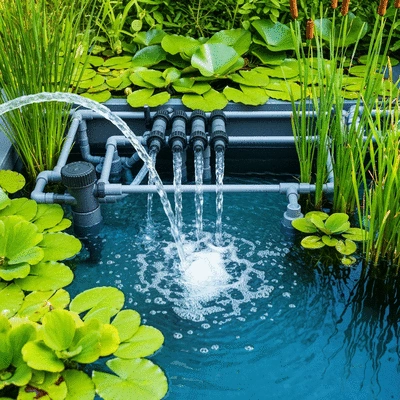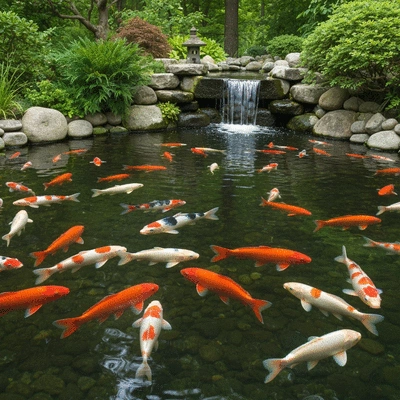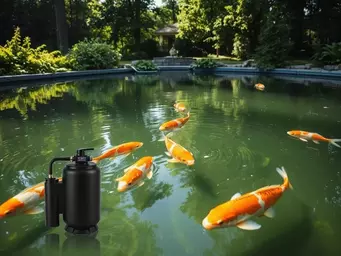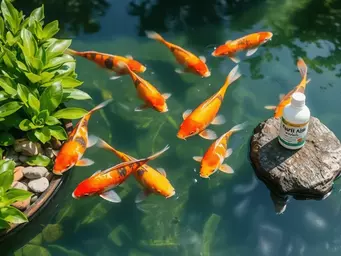Filtration: The Pond's Kidneys
Removes debris & harmful substances.
- 1 Mechanical
- 2 Biological
- 3 Chemical (Optional)
Aeration: The Pond's Lungs
Increases dissolved oxygen for koi health.
- ✓ Air Pumps
- ✓ Waterfalls & Fountains
- ✓ Surface Agitators

Did you know that the health of your koi fish is directly linked to the quality of their pond’s filtration and aeration systems? Understanding these elements can transform your koi pond into a vibrant aquatic ecosystem, ensuring your fish thrive. Here’s a closer look at the essential insights you’ll gain!
This visual highlights the critical components and methods for maintaining a healthy and vibrant koi pond, focusing on filtration and aeration.
Removes debris & harmful substances.
Increases dissolved oxygen for koi health.
When it comes to maintaining a healthy koi pond, filtration and aeration are fundamental components that every koi enthusiast should prioritize. These systems not only keep the water clear but also create a thriving ecosystem for your koi. As someone who has spent over a decade in this rewarding hobby, I can confidently say that understanding these elements is key to ensuring your fish live vibrant and healthy lives.
Effective filtration systems remove debris and prevent harmful substances from accumulating, while aeration enhances oxygen levels in the water. Together, they form a symbiotic relationship crucial for the health of both koi and the pond itself. For detailed insights on selecting the best filtration systems, you can refer to resources like Living Water Aeration's guide to the best koi pond filters. Let’s take a closer look at how they work and why they’re essential!
Filtration and aeration are like the lungs and kidneys of your koi pond. They work tirelessly to maintain a balanced and clean aquatic environment. Here are a few reasons why they matter:
By ensuring that your koi pond has a robust filtration and aeration system, you're not just improving aesthetics, but you're also enhancing the overall well-being of your fish. Remember, a well-maintained pond is a happy pond!
Dissolved oxygen is a critical factor influencing the health of your koi. These magnificent fish thrive in well-oxygenated water, as it helps them breathe and metabolize efficiently. Low oxygen levels can lead to stress and health problems. For more information on the importance of dissolved oxygen, a comprehensive document on water quality criteria for freshwater aquatic life and wildlife highlights its significance. Here are some effective aeration methods to enhance oxygen distribution:
Incorporating these aeration methods not only increases oxygen levels but also helps in maintaining a stable pond environment, crucial for the long-term health of your koi.

Mechanical filtration is the first line of defense for debris in your pond. These systems work by physically removing particles from the water, which helps keep it clean. The benefits of mechanical filters are substantial:
Having a reliable mechanical filtration system in place is essential for any koi pond owner. It acts as a buffer, ensuring that your koi swim in clean, clear water, which directly impacts their health and happiness.
Biological filtration plays a vital role in maintaining a balanced nitrogen cycle in your pond. This system uses beneficial bacteria to break down harmful ammonia and nitrites, which can be toxic to koi. Key points about biological filters include:
Understanding and implementing biological filtration can enhance the resilience of your koi pond, paving the way for happier, healthier fish.
Chemical filtration involves using specific materials to remove toxins from the water. While it’s not always necessary, it can be beneficial in certain situations. Here’s when and how to consider chemical filtration:
Using chemical filtration wisely can help maintain a balanced environment, but it should complement, not replace, biological and mechanical filtration systems.
UV sterilizers are an excellent tool for controlling harmful pathogens in your pond. They work by exposing water to ultraviolet light, which kills bacteria and parasites. Here are the benefits of adding a UV sterilizer to your setup:
Incorporating a UV sterilizer into your koi pond system can significantly enhance water quality, ensuring a safer and prettier environment for your fish!

According to recent studies, maintaining optimal oxygen levels in your koi pond can increase koi growth rates by up to 30%. This highlights the essential role that aeration plays in not only keeping your fish healthy but also supporting their growth and vitality!
Filtration and aeration are crucial for maintaining a healthy koi pond. Filtration removes debris and harmful substances, keeping the water clear and preventing toxin buildup. Aeration increases dissolved oxygen levels, which is vital for koi respiration, metabolism, and overall health, preventing stress and disease caused by low oxygen.
There are three main types: mechanical, biological, and chemical. Mechanical filtration physically removes particles and debris. Biological filtration uses beneficial bacteria to break down harmful ammonia and nitrites. Chemical filtration uses specific media like activated carbon to remove toxins, typically used as a complementary system.
Aeration provides essential dissolved oxygen, allowing koi to breathe and metabolize efficiently. Adequate oxygen levels prevent stress, support healthy growth rates, and contribute to a stable pond environment, reducing the risk of disease.
Common aeration methods include air pumps that drive air through diffusers at the pond's bottom, waterfalls and fountains that create surface agitation, and surface agitators specifically designed to improve water movement and gas exchange.
UV sterilizers are highly recommended for enhancing water quality. They expose water to ultraviolet light, effectively killing harmful bacteria, parasites, and algae, which leads to clearer water and healthier fish by reducing pathogens.
As koi pond enthusiasts, we all understand that maintaining a healthy koi pond is a journey filled with discovery and joy. Selecting the right filtration and aeration systems is crucial not only for the health of your koi fish but also for the overall aesthetics of your pond. For comprehensive guidance on pond filtration, Aquascape Inc. provides valuable information on how pond filtration works. With the right systems in place, you can create a beautiful aquatic environment that not only supports the well-being of your fish but also enhances the visual appeal of your backyard oasis.
When it comes to filtration, remember that both mechanical and biological filters play distinct yet complementary roles. Meanwhile, aeration ensures your koi receive the oxygen they need to thrive. Investing in high-quality systems tailored to your pond's specific needs will pay off in vibrant colors and active fish!
Remember, a well-maintained koi pond is not just about keeping fish; it’s about creating a living ecosystem that flourishes with care and attention. I believe that every little effort you put in will bring you closer to achieving that stunning koi haven you envision!
Now that you have a clearer understanding of the vital role filtration and aeration play in your koi pond, it’s time to take action! Start by assessing your current systems—are they meeting the needs of your koi and the overall pond ecosystem? If you find gaps or areas for improvement, consider upgrades that can enhance your pond's health and beauty.
Here are some next steps to guide you:
At Best Koi Ponds, we are committed to helping you cultivate a vibrant, thriving koi pond. Whether you're a seasoned enthusiast or just starting, taking these steps will ensure your koi have a safe and beautiful home. Together, we can transform your vision of a perfect pond into reality!
Here is a quick recap of the important points discussed in the article:
Koi Care: Filtration and Aeration

Did you know that the health of your koi fish is directly linked to the quality of their pond’s fi
Koi Pond Care: Natural vs. Chemical

As the vibrant colors of koi glide beneath the water's surface, did you know that maintaining optima
Koi Care: Filtration and Aeration
Koi Pond Care: Natural vs. Chemical
Creating a Healthy Koi Pond
Maintaining Koi Pond Water Quality
Koi Pond Shape and Size Guide